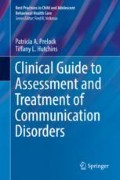Abstract
Approximately 8% of children between the ages of 3 and 17 will exhibit a speech problem. Primary care providers are likely to encounter the following three types of speech disorders: (1) speech sound disorders, i.e., the misproduction of speech sounds and word shapes; (2) fluency disorders, i.e., interruptions to the smooth flow of speech; and (3) voice disorders, i.e., decreases in the quality of the laryngeal sound stream. Children with speech sound disorders, stuttering, or voice disorders are often viewed more negatively both by their teachers and by their peers; these conditions can have lifelong social, academic, and occupational impacts. Healthcare providers should identify children in need of a speech evaluation by asking about how their speech compares to that of their peers, the sounds the children use, how well they are understood, the level of effort that speaking seems to require, the rate of progress observed, and whether or not frustration or embarrassment is evident (in the children or the parents). In some cases, invasive interventions such as surgery are warranted. However, the vast majority of speech problems can be addressed through therapy provided by a well-trained speech-language pathologist. Outcomes are better when assessment and intervention occur promptly.
Access this chapter
Tax calculation will be finalised at checkout
Purchases are for personal use only
References
Ambrose, N. G., & Yairi, E. (1999). Normative disfluency data for early childhood stuttering. Journal of Speech, Language and Hearing Research, 42, 895–909.
American Speech-Language-Hearing Association (n.d.). Fluency Disorders in Childhood (Practice Portal). Retrieved from http://www.asha.org/Practice-Portal/Clinical-Topics/Childhood-Fluency-Disorders.
Andrianopoulos, M. V., Darrow, K., & Chen, J. (2001). Multimodal standardization of voice among four multicultural populations formant structures. Journal of Voice, 15(1), 61–77.
Black, L. I., Vahratian, A., & Hoffman, H. J. (2015). Communication disorders and use of intervention services among children aged 3–17 years: United States, 2012 NCHS Data Brief. Hyattsville, MD: National Center for Health Statistics.
Crelin, E. (1987). The human vocal tract. New York: Vantage.
Guitar, B., & Conture, E. (2013). To the pediatrician. Memphis, TN: Stuttering Foundation of America.
Hooper, C. R. (2004). Treatment of voice disorders in children. Language Speech and Hearing Services in the Schools, 35, 320–326.
Lewis, B. A., & Freebairn, L. A. (1992). Residual effects of preschool phonology disorders in grade school, adolescence, and adulthood. Journal of Speech and Hearing Research, 35, 819–831.
Messner, A. H., & Lalakea, M. L. (2002). The effect of ankyloglossia on speech in children. Otolaryngology - Head and Neck Surgery, 127(6), 539–545.
Miller, J. F., & Leddy, M. (1998). Down syndrome: The impact of speech production on language production. In R. Paul (Ed.), Exploring the speech-language connection (pp. 139–162). Baltimore, MD: Brookes.
Pennington, L., Parker, N. K., Kelly, H., & Miller, N. (2016). Speech therapy for children with dysarthria acquired before three years of age (Review). The Cochrane Library, 7. doi:10.1002/14651858.CD006937.pub3.
Rupela, V., & Manjula, R. (2007). Phonotactic patterns in the speech of children with Down syndrome. Clinical Linguistics and Phonetics, 21(8), 605–622.
Swift, E., & Rosin, P. (1990). A remediation sequence to improve speech intelligibility for students with Down syndrome. Language, Speech and Hearing Services in Schools, 21, 140–146.
Von Berg, S., & McFarlane, S. C. (2002). A collaborative approach to the diagnosis and treatment of child voice disorders. ASHA Special Interest Division #3 Newsletter: Voice and Voice Disorders (March), 19–21.
Other Resources
Author information
Authors and Affiliations
Rights and permissions
Copyright information
© 2018 Springer International Publishing AG, part of Springer Nature
About this chapter
Cite this chapter
Prelock, P.A., Hutchins, T.L. (2018). Children with Speech Disorders. In: Clinical Guide to Assessment and Treatment of Communication Disorders . Best Practices in Child and Adolescent Behavioral Health Care. Springer, Cham. https://doi.org/10.1007/978-3-319-93203-3_8
Download citation
DOI: https://doi.org/10.1007/978-3-319-93203-3_8
Published:
Publisher Name: Springer, Cham
Print ISBN: 978-3-319-93202-6
Online ISBN: 978-3-319-93203-3
eBook Packages: Behavioral Science and PsychologyBehavioral Science and Psychology (R0)

